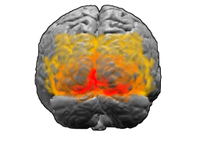
Photo from wikipedia
Flies detect and track moving targets among visual clutter, and this process mainly relies on visual motion. Visual motion is analyzed or computed with the pathway from the retina to… Click to show full abstract
Flies detect and track moving targets among visual clutter, and this process mainly relies on visual motion. Visual motion is analyzed or computed with the pathway from the retina to T4/T5 cells. The computation of local directional motion was formulated as an elementary movement detector (EMD) model more than half a century ago. Solving target detection or figure-ground discrimination problems can be equivalent to extracting boundaries between a target and the background based on the motion discontinuities in the output of a retinotopic array of EMDs. Individual EMDs cannot measure true velocities, however, due to their sensitivity to pattern properties such as luminance contrast and spatial frequency content. It remains unclear how local directional motion signals are further integrated to enable figure-ground discrimination. Here, we present a computational model inspired by fly motion vision. Simulations suggest that the heavily fluctuating output of an EMD array is naturally surmounted by a lobula network, which is hypothesized to be downstream of the local motion detectors and have parallel pathways with distinct directional selectivity. The lobula network carries out a spatiotemporal smoothing operation for visual motion, especially across time, enabling the segmentation of moving figures from the background. The model qualitatively reproduces experimental observations in the visually evoked response characteristics of one type of lobula columnar (LC) cell. The model is further shown to be robust to natural scene variability. Our results suggest that the lobula is involved in local motion-based target detection.
Journal Title: PLOS Computational Biology
Year Published: 2023
Link to full text (if available)
Share on Social Media: Sign Up to like & get
recommendations!